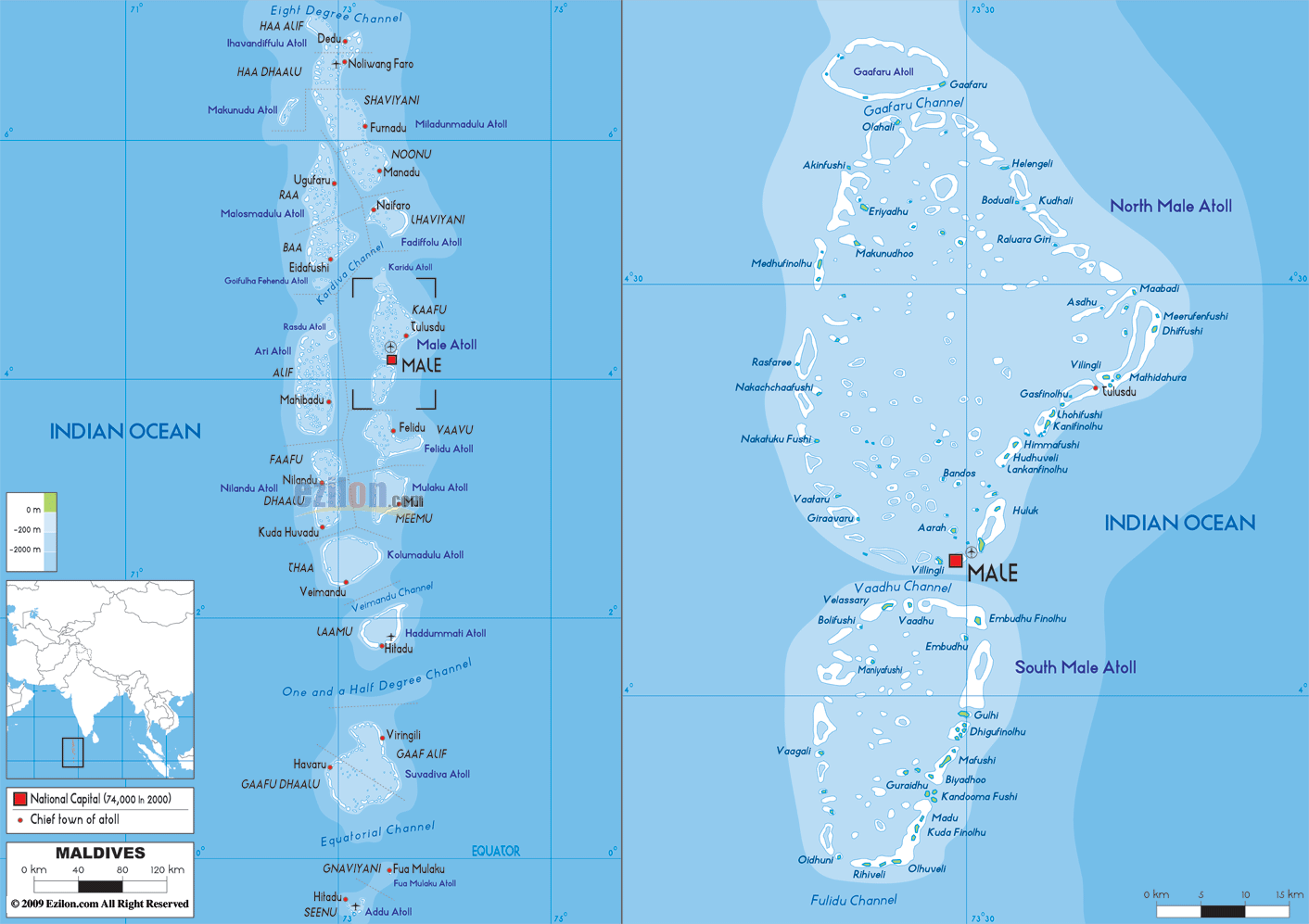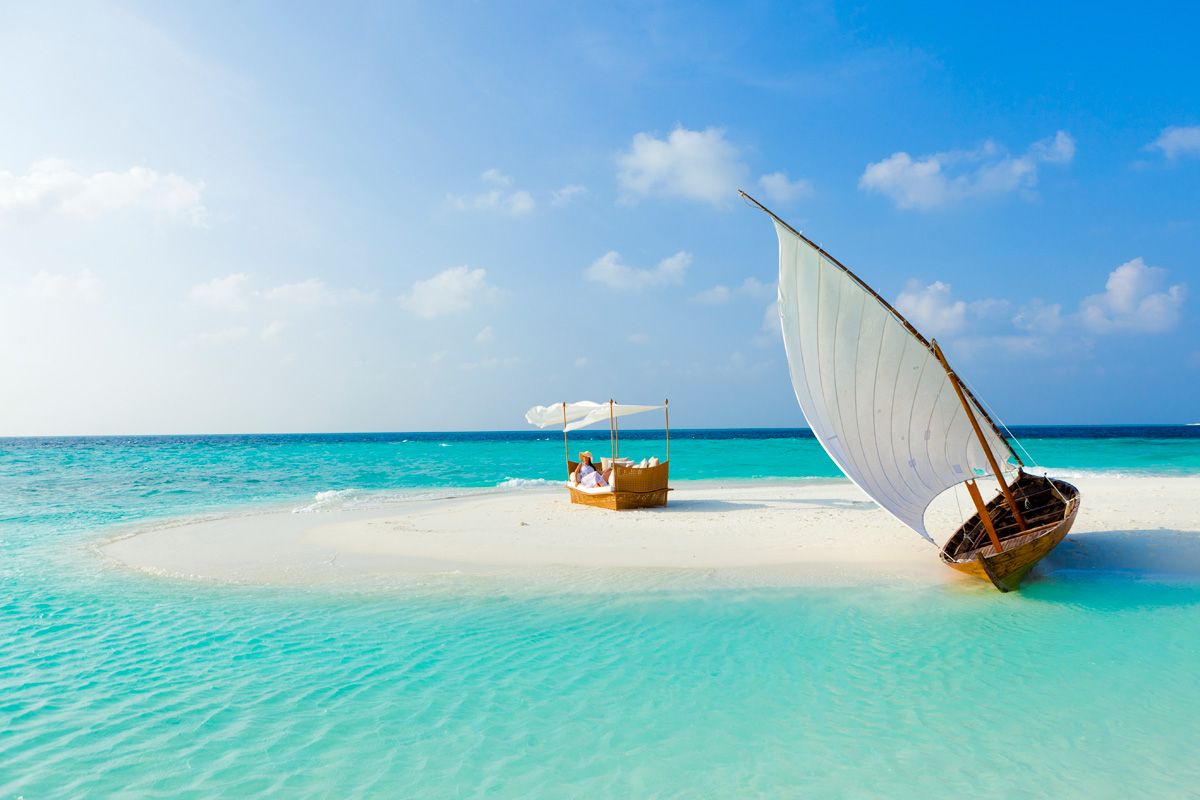The Republic of the Maldives is an archipelagic nation in the Indian Ocean southwest of Sri Lanka and India that is renowned for its beautiful beaches, crystal clear blue lagoons, and extensive, colorful reefs. The ocean-bound South Asian Island nation is comprised of 26 ring-shaped atolls consisting of dual island chains, which are made up of around 1,190 islands and sandbanks.
Stretching from Ihavandhippolhu Atoll in the north to the Addu City in the south, these atolls comprise a territory of roughly 115 square miles, making the Maldives one of the world’s most geographically dispersed countries. Home to approximately 444,259 inhabitants, the Maldives is ranked as the 174th most populated country in the world, with a quarter of the population living in the capital city of Malé, making it one of the most densely populated cities on the planet.

Geography
The Maldives is comprised of 1,192 coral islands that form a double chain of 26 atolls running in a north-south direction and spanning roughly 35,000 square miles. The atolls are made up of live coral reefs and sandbanks that rest on top of a vast submarine mountain range in the Indian Ocean known as the Chagos-Laccadive Ridge that runs from north to south for 600 miles. Rising from the depths of the Indian Ocean, the vast Chagos-Laccadive Ridge forms a terrestrial ecoregion together with the Lakshadweep. This natural coral barricade opens into two passages near the southern end of the ridge to allow safe navigation of vessels from one side of the Indian Ocean to the other through the territorial waters of Maldives.
Of the 1,190 islands in the Maldives, only 200 are inhabited by local Maldivian people, nearly 100 islands have been developed as tourist resorts, and the remaining islands are uninhabited. The largest island of Maldives is Gan, which belongs to the Laamu Atoll or Hahdhummathi Maldives, and the westernmost islands in the Addu Atoll are connected by nine miles of roads that run over the reef.
The atolls of the Maldives have been organized into 21 divisions for administrative purposes by the Maldivian government, and of the 26 geographical atolls, most of the resorts are in North Malé, South Malé, Ari, Felidhu, Baa and Lhaviyani Atolls.
Lying between latitudes 1°S and 8°N, and longitudes 72°and 74°E, the Maldives is approximately 4 feet and 11 inches above sea level, with the highest natural point being seven feet and 10 inches, making it the world’s lowest country. While these ground elevation levels have been increased to several feet where construction exists, more than 80 percent of the country’s land is composed of coral islands which rise less than four feet above sea level. As a result, the Maldives are at extremely high risk of being submerged due to rising sea levels as a result of climate change.

History
The history of the Maldives echoes that of any small, isolated and peaceful nation trying to fend off powerful neighbors and would-be colonizers, however, before the country’s conversion to Islam in 1153, little of its history is known. Friendly and hospitable, yet fiercely proud and independent, the Maldivian character has been shaped by its tumultuous past, including the pre-Muslim period, albeit full of heroic myths and conjecture.
Early days
Archeologists believe that the Maldives dates back to around 2000 BC when it was a trading junction for several ancient maritime civilizations including Egyptians, Mesopotamians, Romans, and Indus Valley Traders. It is thought that the legendary sun-worshipping people called the Redin developed from these groups and were later absorbed by Buddhists from Sri Lanka and Hindus from northwest India, who left evidence of their occupation of the islands southern atolls with dome-shaped structures known as hawittas and Buddhist stupas.
Conversion to Islam
Known as ‘Money Isles,’ due to the enormous quantities of cowrie shells (an international currency of the early ages) they provided, the Maldives (known then as Dibajat) was frequently visited by Arab traders on their way to the Far East as early as the 2nd century AD. The Maldives was converted to Islam in 1153 by a North African Arab known as Abu Al Barakat, and a series of six Sultanic dynasties followed with a total of 84 sultans and sultanas.
The Portuguese
Early in the 16th century, the Portuguese moved into the Maldives from their already well-established base in Goa, India and what began as building a simple fort in Malé ended in 15 years of rule by Portuguese captain ‘Andiri Andirin.’ Except for several months of Malabar domination in Malé during the 18th century, this was the only time that another country has occupied the Maldives. The Portuguese ultimately decreed that Maldivians must convert to Christianity or be killed, and there was ongoing resistance, particularly from Mohammed Thakurufaanu, who started a series of guerrilla raids and an attack on Malé in which all the Portuguese were slaughtered. Thakurufaanu became the Maldives’ greatest hero and went onto found the next sultanic dynasty, the Utheemu, which ruled for 120 years and introduced many new reforms, including a new judicial system, a new monetary system to replace the cowrie currency, and a defense force. There is a memorial center on the island of Utheemu dedicated to him, and the victory is commemorated annually as National Day on the first day of the third month of the lunar year.

Protected Independence
After continued attacks by the Portuguese, the Maldives accepted the protection of the Dutch in the 17th century, who ruled Ceylon at the time, had a short-lived defense treaty with the French, and maintained good relations with the British, enabling them to continue internal autonomy while staying safe from external threats.
The 20th century
The Maldives’ first constitution was imposed upon Sultan Shamsuddin in 1932, marking the dawn of true Maldivian statehood. Shamsuddin was deposed in 1934, and Hasan Nurudin became sultan. Following the hardships of the Second World War, a new constitution was introduced in 1942, and Nurudin was persuaded to abdicate the following year. The government was left in control of the prime minister, Mohammed Amin Didi, who instituted a broad modernization program, nationalized the fish export industry, and introduced an unpopular ban on tobacco smoking.
Following the independence of Ceylon in 1948, the Maldivians signed a defense pact with the British, giving them control of the foreign affairs of the islands, but not the right to interfere internally. While Britain did not overtly interfere in the running of the country, they gained a vital foothold in the Indian Ocean after the loss of India and established a wartime airfield on Gan Island in the southernmost atoll of the country, Addu during the Second World War.
In 1965 Britain recognized the islands as a completely sovereign and independent state and ceased to be responsible for their defense. The Maldives was granted independence on 26 July 1965.
Since then, the country has not been without its problems, including several coups against self-proclaimed reformer President Maumoon Abdul Gayoom, along with issues typical of developing nations such as regional disparities, the environmental effects of growth, income inequality, youth unemployment, and rapid growth in the capital city.
The 1990s saw the Maldives develop hugely, including the implementation of a modern telecommunications system, mobile phones, and the Internet, as well as electricity, essential hospitals higher secondary schools in the outer atolls.
Democracy
More recently the history of the country has been defined by the dictatorship of Maumoon Abdul Gayoom, who remained president for three decades and has been jokingly referred to as “the CEO of the Maldives,” because he ran it like a giant tourist corporation. However, in October 2008 the country held its first freely contested elections with Mohammed Nasheed taking 53.65% of the votes and becoming the country’s first democratically elected leader.
A radical reform and liberalization agenda was set in motion in the first few months of the new administration, and pledges such as making the Maldives a carbon-neutral country, a total ban on shark hunting, and a plan for a national transportation network within a decade were made.

Climate
The Maldives has a year-round hot tropical climate with two monsoon seasons – the dry season associated with the northeastern winter monsoon, which lasts from November to April, and the rainy southwest monsoon season which lasts from May to October and brings strong winds and storms. The monsoonal influence is more significant in the north than in the south, which is more influenced by the equatorial currents. The annual rainfall averages 100 inches in the north and 150 inches in the south, and even during the monsoon seasons, the air temperature rarely falls below 25°C (77°F).

Language
The official and common language of the Maldives is Dhivehi, also known as Divehi or Maldivian, which is an Indo-Aryan language spoken around the country and is closely related to the Sinhalese language of Sri Lanka. Many languages have influenced the development of the Maldivian language through the ages, including Arabic, Persian, French, Portuguese, and English. For example, the English words of ‘atoll’ and ‘dhoni’ are anglicised forms of the Maldivian words ‘atoḷu’ and ‘dōni.’ The major dialects of Maldivian are Malé, Addu, Mulaku, Maliku, Huvadhu, and Haddhunmathee, and Maldivian is written in the Thaana script.
Economy
Industry in the Maldives has always been based around the ocean, with ancient trading items including dried tuna fish, ambergris, coco de mer, coir rope, and cowrie shells, which were also the international currency of the early ages. From the 2nd century AD, the Maldives were known as the ‘Money Isles’ by the Arabs and provided enormous quantities of cowrie shells to the world, including being introduced to Africa during the period of slave trade. The cowrie shell is now the symbol of the Maldives Monetary Authority.
Today, the Maldivian economy is largely dependent on tourism, while agriculture and manufacturing play a lesser role in the economy, constrained by the limited availability of cultivable land and the shortage of domestic labor. Tourism has given a significant boost to the country’s burgeoning cottage industries such as handicraft, mat weaving, coir rope making, and lacquer work, and new industries that have emerged include brick-making, printing, water bottling, and marine engine repairs.

Tourism
The development of tourism in the Maldives has fostered the overall growth of the country’s economy over the past 30 years, developing from a mostly unknown nation to one of the world’s most attractive travel destinations. Tourism in the Maldives began with just two resorts that offered a capacity of about 280 beds, and today there are over 105 resorts located across both the north and south atolls. Today, tourism accounts for 28% of the GDP and over 90% of government tax revenue come from import duties and tourism-related taxes.
Regardless of their country of origin, visitors to the Maldives do not need to apply for a visa pre-arrival, provided they have a valid passport, proof of onward travel, and enough money to be self-sufficient while in the country.
Article by Mia Russell©




[…] pick for honeymooners, families, and couples looking for a quiet retreat to enjoy time together. Sun, sand, and sea is what the Maldives is all about. The barefoot luxury is phenomenal, with the glamour of the […]
[…] beaches, luxurious resorts, incredible reef systems and fabulous weather. In short, the full barefoot in paradise package. What many don’t know is that the Maldives is also home to plenty of other attractions, […]
[…] pick for honeymooners, families, and couples looking for a quiet retreat to enjoy time together. Sun, sand, and sea is what the Maldives is all about. The barefoot luxury is phenomenal, with the glamour of the […]
[…] you want to learn more about the Maldives? Click on this link for a very interesting article about this […]